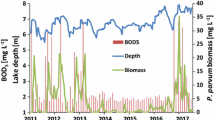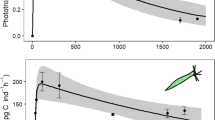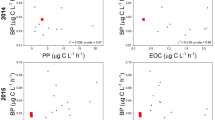Abstract
Autotrophs, mixotrophs and bacteria exhibit complex interrelationships containing multiple ecological mechanisms. A mathematical model based on ecological stoichiometry is proposed to describe the interactions among them. Some dynamic analysis and numerical simulations of this model are presented. The roles of autotrophs and mixotrophs in controlling bacterioplankton are explored to examine the experiments and hypotheses of Medina–Sánchez, Villar–Argaiz and Carrillo for La Caldera Lake. Our results show that the dual control (bottom-up control and top-down control) of bacteria by mixotrophs is a key reason for the ratio of bacterial and phytoplankton biomass in La Caldera Lake to deviate from the general tendency. The numerical bifurcation diagrams suggest that the competition between phytoplankton and bacteria for nutrients can also be an important factor for the decrease of the bacterial biomass in an oligotrophic lake.








Similar content being viewed by others
References
Boehrer B, Schultze M (2008) Stratification of lakes. Rev Geophys 46(2):1–27
Chang XY, Shi JP, Wang H (2021) Spatial modeling and dynamics of organic matter biodegradation in the absence or presence of bacterivorous grazing. Math Biosci 331:108501
Chen M, Fan M, Liu R, Wang XY, Yuan X, Zhu HP (2015) The dynamics of temperature and light on the growth of phytoplankton. J Theor Biol 385(21):8–19
Crandall MG, Rabinowitz PH (1971) Bifurcation from simple eigenvalues. J Funct Anal 8(2):321–340
Crane KW, Grover JP (2010) Coexistence of mixotrophs, autotrophs, and heterotrophs in planktonic microbial communities. J Theor Biol 262(3):517–527
Edwards KF (2019) Mixotrophy in nanoflagellates across environmental gradients in the ocean. Proc Natl Acad Sci USA 116(13):6211–6220
Grover JP (2003) The Impact of variable stoichiometry on predator-prey interactions: a multinutrient approach. Am Nat 162(1):29–43
Heggerud CM, Wang H, Lewis MA (2020) Transient dynamics of a stoichiometric cyanobacteria model via multiple-scale analysis. SIAM J Appl Math 80(3):1223–1246
Hsu SB, Lou Y (2010) Single phytoplankton species growth with light and advection in a water column. SIAM J Appl Math 70(8):2942–2974
Huisman J, Weissing FJ (1994) Light-limited growth and competition for light in well-mixed aquatic environments: an elementary mode. Ecology 75(2):507–520
Jiang DH, Lam KY, Lou Y, Wang ZC (2019) Monotonicity and global dynamics of a nonlocal two-species phytoplankton model. SIAM J Appl Math 79(2):716–742
Kong JD, Salceanu P, Wang H (2018) A stoichiometric organic matter decomposition model in a chemostat culture. J Math Biol 76(3):609–644
Li X, Wang H, Kuang Y (2011) Global analysis of a stoichiometric producer-grazer model with holling type functional responses. J Math Biol 63(5):901–932
Loladze I, Kuang Y, Elser JJ (2000) Stoichiometry in producer-grazer systems: linking energy flow with element cycling. Bull Math Biol 62:1137–1162
Loladze I, Kuang Y, Elser JJ, Fagan WF (2004) Competition and stoichiometry: coexistence of two predators on one prey. Theor Popul Biol 65(1):1–15
Lv DY, Fan M, Kang Y, Blanco K (2016) Modeling refuge effect of submerged macrophytes in lake system. Bull Math Biol 78(4):662–694
Medina-Sánchez JM, Villar-Argaiz M, Carrillo P (2004) Neither with nor without you: a complex algal control on bacterioplankton in a high mountain lake. Limnol Oceanogr 49(5):1722–1733
Mischaikow K, Smith H, Thieme HR (1995) Asymptotically autonomous semiflows: chain recurrence and Lyapunov functions. Trans Am Math Soc 347(5):1669–1685
Moeller HV, Neubert MG, Johnson MD (2019) Intraguild predation enables coexistence of competing phytoplankton in a well-mixed water column. Ecology 100(12):e02874
Nie H, Hsu SB, Wang FB (2019) Steady-state solutions of a reaction-diffusion system arising from intraguild predation and internal storage. J Differ Equ 266(12):8459–8491
Nie H, Hsu SB, Wang FB (2020) Global dynamics of a reaction-diffusion system with intraguild predation and internal storage. Discrete Contin Dyn Syst Ser B 25(3):877–901
Peace A, Wang H (2019) Compensatory foraging in stoichiometric producer-grazer models. Bull Math Biol 81:4932–4950
Peace A (2015) Effects of light, nutrients, and food chain length on trophic efficienciesin simple stoichiometric aquatic food chain models. Ecol Model 312:125–135
Peng R, Zhao XQ (2016) A nonlocal and periodic reaction-diffusion-advection model of a single phytoplankton species. J Math Biol 72(3):755–791
Rong X, Sun Y, Fan M, Wang H (2020) Stoichiometric modeling of aboveground-belowground interaction of herbaceous plant and two herbivores. Bull Math Biol 82:107
Shi JP, Wang XF (2009) On global bifurcation for quasilinear elliptic systems on bounded domains. J Differ Equ 246(7):2788–2812
Sterner RW, Elser JJ (2002) Ecological stoichiometry: the biology of elements from molecules to the biosphere. Princeton University Press, Princeton
Stickney HL, Hood RR, Stoecker DK (2000) The impact of mixotrophy on planktonic marine ecosystems. Ecol Model 125(2–3):203–230
Wang H, Smith HL, Kuang Y, Elser JJ (2007) Dynamics of stoichiometric bacteria-algae interactions in the epilimnion. SIAM J Appl Math 68(2):503–522
Wang H, Kuang Y, Loladze I (2008) Dynamics of a mechanistically derived stoichiometric producer-grazer model. J Biol Dyn 2(3):286–296
Wüest A, Lorke A (2003) Small-scale hydrodynamics in lakes. Annu Rev Fluid Mech 35(1):373–412
Wilken S, Verspagen JMH, Naus-Wiezer S, Van Donk E, Huisman J (2014) Comparison of predator-prey interactions with and without intraguild predation by manipulation of the nitrogen source. Oikos 123(4):423–432
Wilken S, Verspagen JMH, Naus-Wiezer S, Van Donk E, Huisman J (2014) Biological control of toxic cyanobacteria by mixotrophic predators: an experimental test of intraguild predation theory. Ecol Appl 24(5):1235–1249
Yoshiyama K, Nakajima H (2002) Catastrophic transition in vertical distributions of phytoplankton: alternative equilibria in a water column. J Theor Biol 216(4):397–408
Zhang JM, Kong JD, Shi JP, Wang H (2021) Phytoplankton competition for nutrients and light in a stratified lake: a mathematical model connecting epilimnion and hypolimnion. J Nonlinear Sci 31:35
Zhang JM, Shi JP, Chang XY (2021) A model of algal growth depending on nutrients and inorganic carbon in a poorly mixed water column. J Math Biol 83:15
Zhang JM, Shi JP, Chang XY (2018) A mathematical model of algae growth in a pelagic-benthic coupled shallow aquatic ecosystem. J Math Biol 76(5):1159–1193
Author information
Authors and Affiliations
Contributions
All authors contributed equally to the manuscript and typed, read and approved the final manuscript.
Ethics declarations
Conflict of interest
The authors declare that they have no conflict of interest.
Additional information
Publisher's Note
Springer Nature remains neutral with regard to jurisdictional claims in published maps and institutional affiliations.
Yan and Zhang are supported by NSFC-11971088 and NSFHLJ-LH2021A003; Wang is supported by NSERC Discovery Grant RGPIN-2020-03911 and NSERC Accelerator Grant RGPAS-2020-00090.
Appendix
Appendix
Proof of Theorem 1
Let \(\Phi =AQ_{a}+MQ_{m}+qB+N\). It follows from (1) that
and then \(\limsup \limits _{t\rightarrow \infty }\Phi (t)\le N_{b}\). Note that \(Q_{\min ,a}\le Q_a(t)\le Q_{\max ,a},Q_{\min ,m}\le Q_m(t)\le Q_{\max ,m}\) for all \(t\ge 0\). Then
From the last equation of (1), we have
for sufficiently large t and
This means that the set \(\Delta \) is a globally attracting region and system (1) is dissipative. \(\square \)
Proof of Theorem 2
By using local bifurcation theory in (Crandall and Rabinowitz 1971), we first show that \(E_3\) bifurcates from \(E_2\) at \(d_b=d_{b1}\). Define a mapping \(F:{\mathbb {R}}^+\times {\mathbb {R}}^5\rightarrow {\mathbb {R}}^5\) by
It is easy to see that \(F(d_{b},A_2,Q_{a_2},N_2,0,C_2)=0\). Let
For any \((\xi _1,\xi _2,\xi _3,\xi _4,\xi _5)\in {\mathbb {R}}^5\), we have
where
If \((\xi _1,\xi _2,\xi _3,\xi _4,\xi _5) \in \ker P\), then
Let \(\xi _4=1\), then it is clear that (A.1) has a unique solution \((\hat{\xi }_{1},\hat{\xi }_{2},\hat{\xi }_{3},1,\hat{\xi }_{5})\). Then \(\dim \ker P=1\) and \(\ker P={{\,\mathrm{span}\,}}\{\hat{\xi }_{1},\hat{\xi }_{2},\hat{\xi }_{3},1,\hat{\xi }_{5}\}\). It is also noted that \({{\,\mathrm{codim}\,}}{{\,\mathrm{range}\,}}P=1\) as
and
From Theorem 1.7 in (Crandall and Rabinowitz 1971), there exists a \(\delta _1>0\) such that all positive coexistence steady states of (3) near \((d_{b1},A_2,Q_{a_2},N_2,0,C_2)\) lie on a smooth curve
with the form
Then part (ii) holds.
We next establish global bifurcation of positive coexistence steady states of (3). Let \(\Upsilon \) be the set of all positive coexistence steady states of (3). It can be seen that the conditions of Theorem 3.3 and Remark 3.4 in (Shi and Wang 2009) hold. This shows that there exists a connected component \(\Upsilon ^+\) of \(\Upsilon \) such that it includes \(\Gamma _{ba}\), and its closure contains the bifurcation point \((d_{b1},A_2,Q_{a2},N_2,0,C_2)\). Moreover, \(\Upsilon ^+\) has one of the following three cases:
-
(1)
it is not compact in \({\mathbb {R}}^6\);
-
(2)
it includes another bifurcation point \((\bar{d}_{b},A_2,Q_{a2},N_2,0,C_2)\) with \(\bar{d}_{b}\ne d_{b1}\);
-
(3)
it includes a point \((d_b,A_2+\hat{A},Q_{a2}+\hat{Q}_a,N_2+\hat{N},\hat{B},C_2+\hat{C})\) with \(0\ne (\hat{A},\hat{Q}_a,\hat{N},\hat{B},\hat{C})\in Z\), where Z is a closed complement of \(\ker P={{\,\mathrm{span}\,}}(\hat{\xi }_{1},\hat{\xi }_{2},\hat{\xi }_{3},1,\hat{\xi }_{5})\) in \({\mathbb {R}}^5\).
If the case (3) occurs, then \(\hat{B}=0\), which is a contradiction to \(\hat{B}>0\) since it is a positive steady state. Assume that the case (2) holds and \(\bar{d}_{b}\) is another bifurcation value from \(\Gamma _a\). Hence, there exists a positive coexistence steady state sequence \(\{(d_{b}^n,A^n,Q_a^n,N^n,B^n,C^n)\}\) satisfying
as \(n\rightarrow \infty \). From the fourth equation in (3), we have
Hence
when \(n\rightarrow \infty \), which means that \(\bar{d}_b=d_{b1}\).
The above analysis shows that the case (1) must happen. Then \(\Upsilon ^+\) is not compact in \({\mathbb {R}}^6\). It follows from Theorem 1 that
for all \(d_b\in (0,d_{b1})\). This indicates that the projection of \(\Upsilon ^+\) onto \(d_b\)-axis contains \((0,d_{b1})\). This proves part (i). \(\square \)
Proof of Theorem 3
-
(i)
It is obvious that \(E_4\) always exists. The Jacobian matrix at \(E_4\) is
$$\begin{aligned} J(E_4)= \begin{pmatrix} a_{11} &{}\quad 0 &{}\quad 0&{}\quad 0&{}\quad 0\\ a_{21} &{}\quad a_{22} &{}\quad a_{23}&{}\quad a_{24} &{}\quad 0\\ a_{31} &{}\quad 0&{}\quad a_{33} &{}\quad 0 &{}\quad 0\\ 0 &{} \quad 0 &{}\quad 0&{}\quad a_{44} &{}\quad 0\\ a_{51} &{}\quad a_{52} &{}\quad 0 &{}\quad a_{54}&{}\quad a_{55} \end{pmatrix}, \end{aligned}$$where
$$\begin{aligned} a_{11}&=\mu _{m}(0,Q_{m4},0)-d_{m}-\frac{v_{m}+D}{L}, a_{21}=-\frac{\partial \mu _{m}}{\partial M}(0,Q_{m4},0)Q_{m4},\\ a_{22}&=\frac{\partial \rho _m}{\partial Q_m}(Q_{m4})g_m(N_b)-r_m\bar{I}_m(0,0), a_{23}=\rho _{m}(Q_{m4})\frac{\partial g_m}{\partial N}(N_b),\\ a_{24}&=\frac{aq}{\delta }-\frac{\partial \mu _{m}}{\partial B}(0,Q_{m4},0)Q_{m4}, a_{31}=-\rho _{m}(Q_{m4})g_{m}(N_{b}),~ a_{33}=-\frac{D}{L},\\ a_{44}&=-d_{b}-\frac{D}{L}, a_{51}=\frac{\partial \mu _{c}}{\partial M}(0,Q_{m4}), a_{52}=\frac{\partial \mu _{c}}{\partial Q_{m}}(0,Q_{m4}),\\ a_{54}&=-\frac{r_{b}}{\gamma }g_{b}(N_b,0), a_{55}=-\frac{D}{L}. \end{aligned}$$It can be observed that \(J(E_4)\) has five eigenvalues \(a_{ii}\), \(i=1,\cdots ,5\). Note that \(a_{ii}<0\) for \(i=2,3,4,5.\) Therefore, if \(d_m>d_m^*\) holds, then \(a_{11}<0\). This means that all the five eigenvalues of \(J(E_4)\) have negative real parts. This shows that \(E_4\) is locally asymptotically stable.
-
(ii)
The existence of \(E_5\) is from Theorem 2 in (Wang et al. 2007). The Jacobian matrix at \(E_5\) is
$$\begin{aligned} J(E_{5})= \begin{pmatrix} a_{11} &{}\quad a_{12} &{}\quad 0&{}\quad a_{14}&{}\quad 0\\ a_{21} &{}\quad a_{22} &{}\quad a_{23}&{} \quad a_{24} &{}\quad 0\\ a_{31} &{}\quad a_{32}&{}\quad a_{33} &{}\quad a_{34} &{}\quad 0\\ 0 &{}\quad 0 &{}\quad 0 &{}\quad a_{44} &{}\quad 0\\ a_{51} &{}\quad a_{52} &{}\quad 0 &{}\quad a_{54}&{}\quad a_{55} \end{pmatrix}, \end{aligned}$$where
$$\begin{aligned} \begin{aligned} a_{11}&=\frac{\partial \mu _{m}}{\partial M}(M_{5},Q_{m5},0)M_5,\\a_{12}&=\frac{\partial \mu _{m}}{\partial Q_{m}}(M_5,Q_{m5},0)M_5,\\a_{14}&=\frac{\partial \mu _{m}}{\partial B}(M_5,Q_{m5},0)M_5,\\ a_{21}&=-\frac{\partial \mu _{m}}{\partial M}(M_5,Q_{m5},0)Q_{m5}, a_{22}=\frac{\partial \rho _m}{\partial Q_m}(Q_{m5})g_m(N_5)-r_m\bar{I}_m(0,M_5),\\ a_{23}&=\rho _{m}(Q_{m5})\frac{\partial g_m}{\partial N}(N_5), a_{24}=\frac{aq}{\delta }-\frac{\partial \mu _{m}}{\partial B}(M_{5},Q_{m5},0)Q_{m5},\\ a_{31}&=-\rho _{m}(Q_{m5})g_{m}(N_{5}), a_{32}=-\frac{\partial \rho _m}{\partial Q_m}(Q_{m5})g_m(N_5)M_5,\\ a_{33}&=-\frac{D}{L}-\rho _{m}(Q_{m5})\frac{\partial g_{m}}{\partial N}(N_5)M_5, a_{34}=-qr_bg_b(N_5,C_5),\\ a_{44}&=r_{b}g_{b}(N_5,C_5)-d_{b}-\frac{D}{L}-\frac{a}{\delta }M_5, a_{51}=\frac{\partial \mu _{c}}{\partial M}(M_5,Q_{m5}),\\ a_{52}&=\frac{\partial \mu _{c}}{\partial Q_{m}}(M_5,Q_{m5}), a_{54}=-\frac{r_{b}}{\gamma }g_{b}(N_5,C_5), a_{55}=-\frac{D}{L}. \end{aligned} \end{aligned}$$\(J(E_5)\) has eigenvalues \(a_{44}\), \(a_{55}\), and the remaining three eigenvalues satisfy
$$\begin{aligned} \lambda ^3+A_1\lambda ^2+A_2\lambda +A_3=0, \end{aligned}$$where
$$\begin{aligned} A_1&=-(a_{11}+a_{22}+a_{33}),\\ A_2&=a_{11}a_{22}+(a_{11}+a_{22})a_{33}-(a_{23}a_{32}+a_{12}a_{21}),\\ A_3&=-a_{11}a_{22}a_{33} -a_{12}a_{23}a_{31}+a_{11}a_{23}a_{32}+a_{12}a_{21}a_{33}. \end{aligned}$$A direct calculation gives \(A_i>0\), \(i=1,2,3\) and \(A_1A_2-A_3>0\). According to the Routh–Hurwitz criterion, the three eigenvalues have negative real parts. It is clear that \(a_{55}<0\). If \(d_b>d_{b2}\) holds, then \(a_{44}<0\). This shows that all the five eigenvalues of \(J(E_5)\) have negative real parts if \(d_b>d_{b2}\) holds. Hence, \(E_5\) is locally asymptotically stable.
(iii)-(iv) Define a mapping \(G:{\mathbb {R}}^+\times {\mathbb {R}}^5\rightarrow {\mathbb {R}}^5\) by
It follows that \(G(d_b,M_5,Q_{m5},N_5,0,C_5)=0\). Let
For any \((\zeta _1,\zeta _2,\zeta _3,\zeta _4,\zeta _5)\in {\mathbb {R}}^5\), we have
where
If \((\zeta _1,\zeta _2,\zeta _3,\zeta _4,\zeta _5) \in \ker H\), then
Let \(\zeta _4=1\), then (A.2) has a unique solution \((\hat{\zeta }_{1},\hat{\zeta }_{2},\hat{\zeta }_{3},1,\hat{\zeta }_{5})\). This implies that \(\dim \ker H=1\) and \(\ker H={{\,\mathrm{span}\,}}\{\hat{\zeta }_{1},\hat{\zeta }_{2},\hat{\zeta }_{3},1,\hat{\zeta }_{5}\}\). It is also easy to show that \({{\,\mathrm{codim}\,}}{{\,\mathrm{range}\,}}H=1\) as
and
By using Theorem 1.7 in (Crandall and Rabinowitz 1971), there exists a \(\delta _2>0\) such that all positive steady states of (8) near \((d_{b5},M_5,Q_{m5},N_5,0,C_5)\) lie on a smooth curve
with the form
This completes the proof of part (iv). Note that the proof of part (iii) is similar to those in Theorem 2. Then we omit it here. \(\square \)
Rights and permissions
About this article
Cite this article
Yan, Y., Zhang, J. & Wang, H. Dynamics of Stoichiometric Autotroph–Mixotroph–Bacteria Interactions in the Epilimnion. Bull Math Biol 84, 5 (2022). https://doi.org/10.1007/s11538-021-00962-9
Received:
Accepted:
Published:
DOI: https://doi.org/10.1007/s11538-021-00962-9




